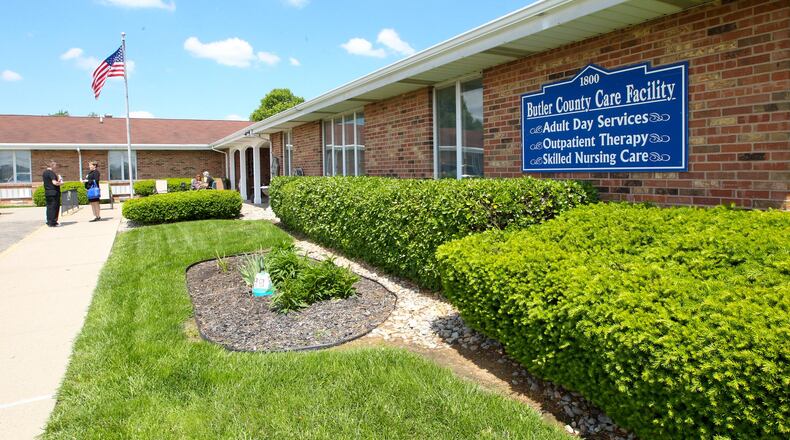She said they have kept tabs on many of the residents at their new homes, “some of them are having a difficult time, but that’s to be expected, it’s all new.” The medical director, ombudsman and social worker have followed up on the residents as well.
“I’m relieved that everyone’s placed, they appear to be relatively content, they’re still adjusting, some satisfied more than others because they’ve been here for so long and this was their home, they still consider it to be their home,” McGee told the Journal-News. “They still call back and talk to Vickie at the receptionist desk and talk to her, and discuss how they’re feeling.”
When the commissioners agreed to close the facility they said they would try to place workers elsewhere within the county, but McGee said only one employee, the maintenance director, has remained within the county. She said 90% to 95% of the employees have found other jobs and the rest are weighing their options.
McGee said she knew when she accepted the job, change was likely coming, and today, “I’m looking earnestly for another position now that the last resident has left.”
What’s next?
Commissioner Don Dixon, whose family is in the extended care business, said the home emptied a little quicker than expected.
“We thought maybe we’d go to the first of the year, but the patient numbers were going down,” Dixon said. “It was inevitable, there’s plenty of occupancy space out in the private sector right now. I knew we wouldn’t have any problem placing those folks, we just had to make the decision how soon we wanted it to happen.”
The commissioners have earmarked $3 million worth of American Rescue Plan Act funding for a Mental Health Crisis Stabilization Center that will be housed in part of the facility. Dixon said that unit will encompass less than half of the building, “so we should have 25,000 or 30,000 feet to do something with.”
“I think there’s going to be some other services delivered here; I think there’s going to be mental health counseling and some different things,” Dixon said. “We’re not sure what all is going to end up there. We’re exploring those opportunities right now.”
The facility, located at 1800 Princeton Road, opened in 1975 providing skilled nursing home care to the infirm and vulnerable populations with little alternative for care.
Albert Peters, president of the Ohio County Home Association, said there are 24 county-run nursing homes left in Ohio. The nursing homes were mandated in all 88 counties when the first facility was built in 1830 to serve the infirm, poor and homeless. Many of the facilities closed after the state legislature lifted the mandate and counties opted to let the private sector handle nursing care as government budgets shrank.
Through the years the commissioners have had to bail the financially fragile nursing home out with general fund cash infusions, for a variety of reasons including ever-shifting Medicaid reimbursement rates. The budget to run the facility was $4.9 million last year.
County home has been plagued with financial woes
Since 2016 the commissioners have transferred roughly $1.7 million from the general fund to the nursing home in annual loans in the $300,000 to $400,000 range. At one time, the county nursing home owed the general fund $1.1 million, a debt the home partially repaid.
Staffing has been a real problem at the home throughout the pandemic, forcing the commissioners to use outside staffing agencies to help run the facility. The commissioners approved several short-term contracts with outside staffing companies have spent around $734,933 as of the end of June. Since the outbreak of the pandemic and through the end of last year the county spent $1.3 million on outside agency workers.
County Administrator Judi Boyko said they have a lot of requirements — Medicaid and otherwise — to fulfill to close out the skilled nursing facility.
“We’ve been working very concertedly over the last eight weeks focusing on contract closure, winding down and assigning where budget really needs to be to assume the rest of the costs as we close,” she said. “Where we are now is the management of the records and inventory and disposal of unfit, obsolete, no longer needed assets.”
As part of the closure the commissioners decided to “sell” 75 of the Centers for Medicaid and Medicare Services skilled nursing bed certifications and put them out to bid. They hoped they might get as much as $750,000. Chris Hacker, the county’s asset, procurement and projects director told the Journal-News they did not receive any bids.
Best practices for mental health crisis center
The Butler County Mental Health and Addiction Recovery Services Board is taking the lead on the crisis center, and Executive Director Scott Rasmus told the Journal-News they are finalizing the request for proposals for the unit and hope to release it next month.
Originally he estimated it would cost $5 million to $6 million annually based on a 20-bed center where people would stay for three days to be stabilized, screened and referred to further service in the community.
Until he gets an architect’s opinion he won’t know the cost to retrofit the nursing home for the new use.
Rasmus and Commissioner Cindy Carpenter were in North Carolina this week touring “best practices” crisis centers. They spoke to the Journal-News after they finished visiting two centers, one in Durham County that costs $7 to $8 million a year to run and the other smaller one in the city of Henderson that costs $3 million to $3.5 million annually.
Carpenter said the Durham County facility serves about 250 people a month and they are similar in size to Butler County. Discussions about the crisis center have been going on for years here and mainly centered on a place where law enforcement can drop people off for care instead of bringing them to jail where they really don’t belong.
Carpenter said one of the best practices she learned on the visit is who utilizes the centers.
“I asked where do the referrals come from for the larger facility that’s serving Durham,” she said. “They come from homeless shelters, police drop-offs, hospitals, walk-ins, other facilities, group homes, their mobile crisis team and sometimes individuals just come in the door and have someone to talk to but don’t stay there. I think that’s the mix we’ll likely mirror.”
Rasmus said they have applied to the state department for mental health and addiction for $750,000 to put toward capital costs for the project and his board would be required to match that amount if they get the grant. He said the funding models in North Carolina are much different because they don’t have Medicaid expansion there, so he is sticking with the $6 million estimate for now.
The exact parameters of the program here will be better defined with the RFP. Rhonda Benson, director of the county’s National Alliance on Mental Illness chapter, said this type of facility has been sorely needed for years.
“There’s that gray area there where they’re really too sick to be on their own at home but they’re not sick enough to get them in anywhere,” Benson said. “It would benefit not just the police but anybody can drop somebody off and they just help stabilize them and identify what type services they need.”
About the Author

